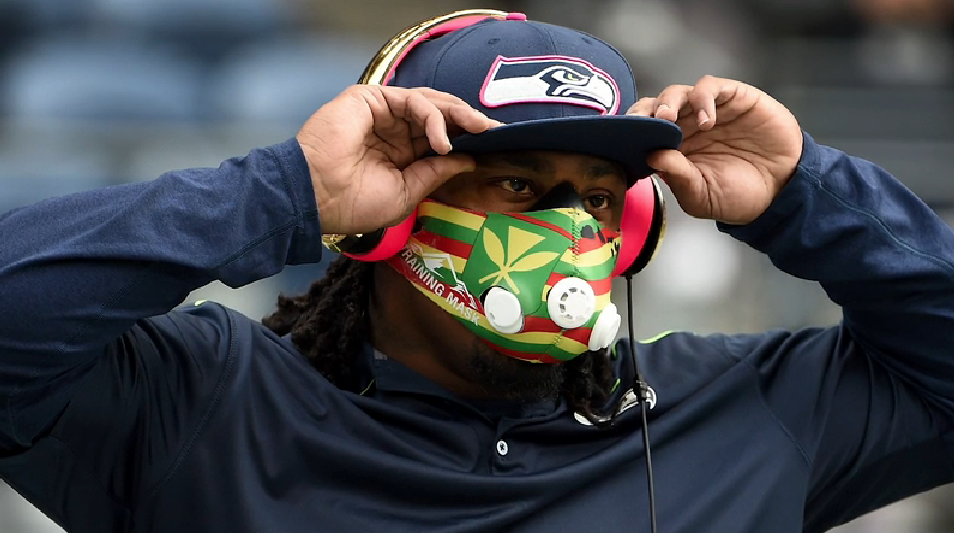Marshawn's Mask, Extreme Fitness, and the Economy

Image Credit: SI.com
In a sport known for its trash talk, boastfulness, and elaborately arcane jargon, Marshawn Lynch’s mouth is the exception. Whether wearing a distinctive mask or remaining taciturn in interviews, one of the world’s greatest rushers has made a name for himself precisely be keeping his mouth closed. This reticence—as well as his resultant struggles with the NFL powers-that-be—that makes him a fascinating icon of our current trust in fitness as a source of security in a very economically uncertain time.
Admittedly, Lynch expresses little interest in being representative for anything universal. While internet memes may project his tackling abilities onto the Bible's first bad-boy story, his 2013 E:60 interview begins with a focus on the hometown whose name is tattooed onto his chest. “I’ll be damned,” Lynch says, “if somebody from Oakland say that Marshawn don’t come back here and be in his community, because that’d be a lie, for sure.” Such local loyalties, not just to his city but to those with whom he has a personal connection, are central to his expressions of guilt and repentance. Asked about his early criminal charges of reckless driving and possession of a concealed handgun, he describes his actions in terms of communal expectations rather than absolute morality: “it was a letdown, you know. It was a letdown to my family, it was a letdown to myself, and it was a letdown to the team that was holding me accountable.” Local loyalties, not grand narratives, saturate Lynch’s self-presentation.
Yet local loyalty doesn’t necessarily translate into the creation of a successful clothing line, nor does it necessarily earn one a super bowl advertisement. For that, one has to turn to another element of Lynch’s persona: his unwillingness to toe the NFL party line. Neither Marshawn’s biography nor his work on behalf of youth—work that includes the Fam 1st Foundation , which teaches such fundamentals as how to balance a checkbook or handle a job interview--has captured the public eye so much as his unwillingness to talk to the media. His iconic PR highlight was not the establishment of his own clothing line, but his letter-of-the-law participation in the Super Bowl Media Day, where he repeated “I’m here so I won’t get fined” 25 times. This same silence drives his super bowl advertisement, where he breaks from his stoic silence only briefly, to gush about Progressive’s automotive insurance. Lynch’s refusal to talk to the media cost him a $100,000 NFL fine, but such fines only add to his brand appeal. “Beast Mode” apparel and super bowl commercials monetize Lynch’s ability to say, or not say, whatever he wants.
Lynch’s famous “Bane-like mask,” pictured at the top of this article, certainly literalizes his silent-man branding: covering his mouth, without words, it nevertheless manages to convey a spirit of rebellion. Yet if the cinematic Bane’s association with Occupy Wall Street rhetoric and armed rebellion allows the mask to carry a certain generalized anti-authoratarianism, Lynch’s mask carries a more prosaic, if still counterintuitive, purpose: it forces Lynch’s lungs to work harder, helping him to develop exceptional long-term and short term lung capacity and endurance.
These two elements of Bane’s mask find a corollary in perhaps the oddest of regions: upper class exercise crazes. Whether through the push-harder excesses of CrossFit coaches or the odd vogue of sledge-hammering tires, extreme fitness has become an immense craze. As a recent New York Times article by Heather Havrilesky puts it, while as late as the 90’s “you still worked out to prepare for the beach or the bedroom,” the upper classes of America now seem to be “preparing for an unforseen natural disaster, or a burning building, or Armageddon.”
It is hard for me not to see a certain commonality between Lynch’s mask—a device intended to make exercise more difficult and reminiscent of a DC super-villain—and the post-apocalyptic overtones present in so many extreme fitness crazes. Both offer participation in a similarly anarchic, individualistic economy: one where sheer personal commitment and hard work can triumph over the impersonal systems that seem to control so many economic destinies. Havrilsky hits on this desire near the end of her essay. She writes, “in these uncertain times, it doesn’t sound so bad to be prepared for some coming disaster—or even for an actual job doing hard labor, if our empire ever falls.” Having a body that seems capable of facing the most extreme of challenges may largely be irrelevant to our economic structure, but it is something solid and real, a comfort in discomforting times. Lynch provides a similar triumph-through-hard-work with a swagger. His mask signifies a mouth beholden to no one, not even the nigh omnipotent NFL system that employs him, even as it signifies the sacrifices required to achieve such a high level of independence. Indeed, as the wealth gap seems to increase uncontrollably and as America’s economy (as well as those of the rest of the world) seems to remain incredibly unstable, Marshawn’s mask seems to signify a modern, optimistic John Henry. Breathing literal thin air, speaking only when and how he pleases, it may be Lynch who fulfills the promise of Batman: not the hero we deserve, but the hero we need.



Add new comment